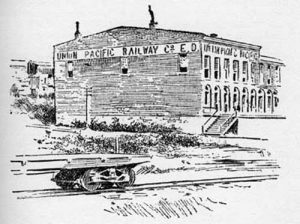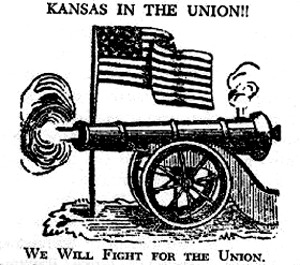
The Wyandotte Constitution meetings were held in the Union Pacific Railway building in Kansas City, Kansas.
The fourth and final Constitutional Convention was authorized by an act of the Territorial Legislature and approved by Governor Medary on February 9, 1859. The convention assembled at Wyandotte, Kansas (Kansas City) on July 5, 1859, and was organized by electing James M. Winchell as president and John A. Martin as secretary. Thirty-five Republicans and seventeen Democrats were chosen to attend the convention. By this time, the issue of slavery had pretty much been decided in the territory. Still, there were other controversial issues to decide, including the eastern boundary of the state, which is now part of Colorado. Also discussed was the possibility of equal voting rights for Kansas women.
Though this didn’t pass, women were given the right to participate in school district elections, to own property, and gave women equal rights in the “possession of their children.” The constitution stated that the legislature was to “provide for their equal rights in possession of their children.” After working diligently for several weeks, the constitution was completed on July 29.
All the Republican members except Thomas S. Wright of Nemaha County signed the document; however, none of the Democrats would sign, as they objected to several key provisions. This created a bitter partisan contest in the subsequent campaign to ratify the constitution. Finally, on October 4, 1859, it was ratified in a vote of the people by nearly a 2 to 1 margin. State officers were elected on December 6, preparatory to admission into the Union. However, more than a year would elapse before these officers were called upon to assume the duties of the positions to which they were elected.
The proposed constitution was prepared and sent to the President of the United States but would take some time to pass the House and the Senate due to pro-slavery advocates. However, when Abraham Lincoln was elected president, many southern states began to leave the Union, and opposition to Kansas’ admission decreased. The last six southern senators left their seats on January 21, 1861, and later that same day, the Senate passed the Kansas bill. A week later, the House passed the bill and sent it to the president for his signature. Ironically, President James Buchanan, a man who had been much despised by most Free-State settlers, signed the bill making Kansas the 34th state on January 29, 1861.
Following is a list of the members of the Wyandotte Convention by districts:
1st – Leavenworth County — Frederic Brown, Robert C. Foster, Samuel Hipple, W. C. McDowell, Adam D. McCune, Pascal C. Parks, William Perry, John P. Slough, Samuel A. Stinson, John Wright.
2nd – Atchison County — Robert Graham, John J. Ingalls, Caleb May.
3d – Doniphan County — John W. Forman, E. M. Hubbard, Robert J. Porter, John Stiarwalt, Benjamin Wrigley.
4th – Brown County — Samuel A. Kingman.
5th – Nemaha County — Thomas S. Wright.
6th – Marshall and Washington Counties — J. A. Middleton.
7th – Jefferson County — C. B. McClelland.
8th – Jackson County — Ephraim Moore.
9th – Riley County — S. D. Houston.
10th – Pottawatomie County — Luther R. Palmer.
11th – Johnson County — J. T. Barton, John T. Burns.
12th – Douglas County — James Blood, N. C. Blood, William Hutchinson, Edwin Stokes, Solon O. Thacher, P. H. Townsend, L. R. Williams.
13th – Shawnee County — J. P. Greer, H. D. Preston, John Ritchie.
14th – Wabaunsee County, Davis, Dickinson, and Clay Counties — Edmund G. Ross.
15th – Lykins County — W. P. Dutton, Benjamin F. Simpson.
16th – Franklin County — James Hanway.
17th – Osage, Breckenridge, Morris, and Chase Counties — William McCullough, James M. Winchell.
18th – Linn County — James M. Arthur, Josiah Lamb.
19th – Anderson County — James G. Blunt.
20th – Coffey and Woodson Counties — Allen Crocker, Samuel E. Hoffman.
21st – Madison, Hunter, Butler, Greenwood, Godfrey, and Wilson counties — George H. Lillie.
22nd – Bourbon, McGee, and Dorn counties — J. C. Burnett, William R. Griffith.
23d – Allen County — James A. Signor.
A glance at the above list will show that the leaders of both the Free-State and pro-slavery parties of former days were absent. James H. Lane, Charles Robinson, Samuel N. Wood, Speer, Charles H. Branscomb, and others who gave such loyal support to the Topeka Constitution was missing; on the other hand, not a single prominent pro-slavery man was among the 17 Democratic delegates. Of the 52 delegates composing the convention, three-fourths of them were under the age of 40 years. It was a young men’s convention. Practically all occupations were represented. There were 18 lawyers, 16 farmers, eight merchants, three manufacturers, three physicians, a surveyor, a printer, a mechanic, and a land agent.
Compiled and edited by Kathy Alexander/Legends of Kansas, updated January 2023.
Also See:
Constitutional Conventions of Kansas
Territorial Kansas & the Struggle for Statehood
About the Article: Much of the historic text in this article comes from Kansas: A Cyclopedia of State History, edited by Frank W. Blackmar, published in 1912, as well as Kansas: History of the State of Kansas, by William G. Cutler, published in 1883. However, other sources have also been used, and the content is combined and heavily edited.

